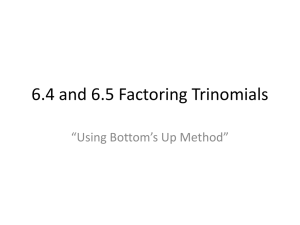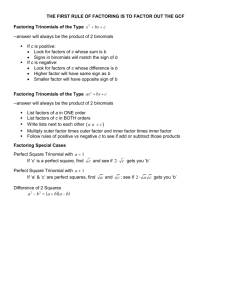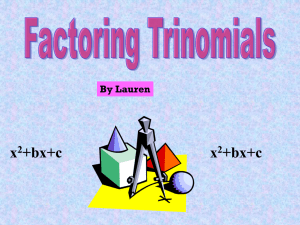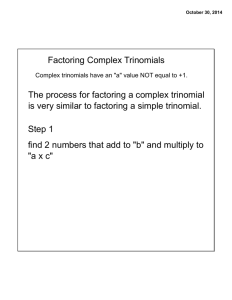Section 14.2 X + B X + C
advertisement
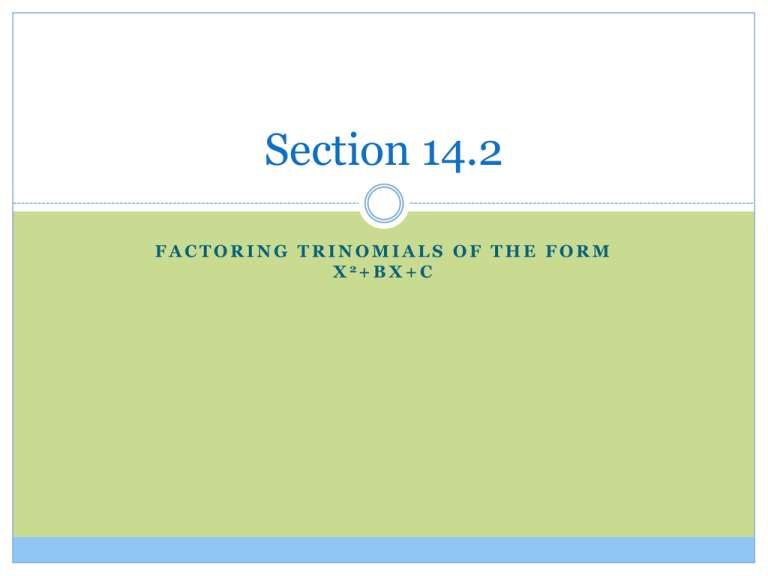
Section 14.2 FACTORING TRINOMIALS OF THE FORM X 2+ B X + C Factoring Trinomials of the Form x2 + bx + c Factor trinomials of the form x2 + bx + c Factor out the greatest common factor and then factor a trinomial of the form x2 + bx + c Factoring Trinomials of the Form x2 + bx + c Multiply the binomials 1. ( x 2)( x 5) x 2 5 x 2 x 10 x 2 7 x 10 2. ( x 3)( x 4) x 2 4 x 3x 12 x 2 x 12 Trinomials of the form x2 + bx + c result from the product of two binomials of the form (x + m)(x + n). Factoring Trinomials of the Form x2 + bx + c Multiply the binomials 1. ( x 2)( x 5) x 2 5 x 2 x 10 x 2 7 x 10 2. ( x 3)( x 4) x 2 4 x 3x 12 x 2 x 12 Notice, the first term in the trinomial comes from the product of the first terms in each binomial. Factoring Trinomials of the Form x2 + bx + c Multiply the binomials 1. ( x 2)( x 5) x 2 5 x 2 x 10 x 2 7 x 10 2. ( x 3)( x 4) x 2 4 x 3x 12 x 2 x 12 Notice, the first term in the trinomial comes from the product of the first terms in each binomial. Notice, the last term in the trinomial comes from the product of the last terms in each binomial. Factoring Trinomials of the Form x2 + bx + c Multiply the binomials 1. ( x 2)( x 5) x 2 5 x 2 x 10 x 2 7 x 10 2. ( x 3)( x 4) x 2 4 x 3x 12 x 2 x 12 Notice, the first term in the trinomial comes from the product of the first terms in each binomial. Notice, the last term in the trinomial comes from the product of the last terms in each binomial. Notice, the middle term in the trinomial comes from the sum of the last terms in the binomial. Factoring Trinomials of the Form x2 + bx + c Proof Multiply (x + m)(x + n) x m x n x 2 nx mx mn x2 n m x mn The middle term, the coefficient of x, is the sum of the constants in the binomials. The last term, the constant, is the product of the constants in the binomials. Factoring Trinomials of the Form x2 + bx + c Trinomials of the form Factor 1. x 19 x8 20 1 20 2 What sums to 9? 27 3 6 ... 1 10 41 50 x4 x5 2 10 Which of 45 these What 1 20 multiplies sum to 9? 2 10 to 20? 4 5 x2 + bx + c result from the product of two binomials of the form (x + m)(x + n) where m+n=b and mn=c. To factor a trinomial: 1. List all factor pairs of c ... Limited AAACK! number of Infinite possibilities! options! 2. 3. Start here since the amount of factors for a number is finite. Find the pair whose sum or difference is b Check the factorization by multiplying it back out If c is positive, m and n will have the same sign and will add to b If c is negative, m and n will have different signs and will subtract to b Factoring Trinomials of the Form x2 + bx + c Trinomials of the form Factor 1. x 9 x 20 2 x 4 x 5 2. x 2 13 x 22 x 2 x 11 3. x 2 5 x 36 x 4 x 9 4. x2 + bx + c result from the product of two binomials of the form (x + m)(x + n) where m+n=b and mn=c. To factor a trinomial: 1. List all factor pairs of c 2. 3. x 2 3x 40 x 8 x 5 Start here since the amount of factors for a number is finite. Find the pair whose sum or difference is b Check the factorization by multiplying it back out If c is positive, m and n will have the same sign and will add to b If c is negative, m and n will have different signs and will subtract to b Factoring Trinomials of the Form x2 + bx + c Special Cases Factor 1. a 2 13ab 30b 2 a 10b a 3b 2. y 2 6 y 15 prime A polynomial that cannot be factored is called prime. Factoring Out the Greatest Common Factor Factor 1. x3 3x 2 4 x 2. Always begin by factoring out the GCF if it exists. x x 1 x 4 5 x5 25 x 4 30 x3 5x3 x 6 x 1

